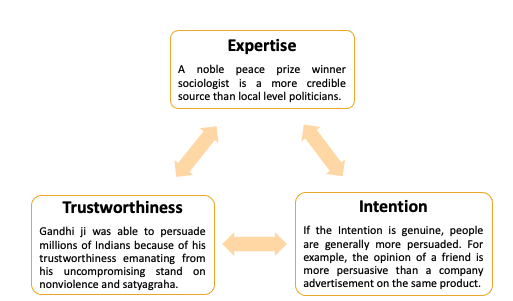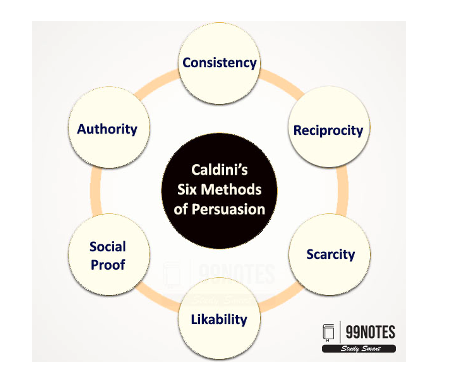Persuasion
Persuasion is defined as the process of changing or reinforcing a person’s attitudes, beliefs, or behaviour in management literature. It is a type of social influence and a process of inducing a change in ideas, beliefs and attitudes of other persons or groups about some issue in a predetermined direction.
Persuasion is done using logic, reasoning and emotional appeal through information passed on to the target group by a credible source through various communication channels.
Persuasion, however, can be used to change attitudes and also to prevent attitudes from changing.
Types of Persuasion:
There are two main routes through which a persuasive message is processed. Viz, central and peripheral. Another auxiliary type is pre-suasive conditioning.
The messages that are delivered for persuasion may be processed either spontaneously (peripherally or heuristically) or thoughtfully (central route). This model is called the Heuristic-Systematic Model of Persuasion.
1. In pre-suasive conditions, a person is exposed to a message repeatedly over time until they become used to it and start to accept it as normal.
2. . Peripheral / Spontaneous Route to Persuasion:
In the Peripheral route to persuasion, a person only pays attention to certain aspects of the argument and accepts what’s being said without thinking about it.
- It is direct, quick, and often involves emotional responses to the message. Spontaneous messages are either pleasant or fearful in nature, as both tend to persuade the audience effectively.
- However, persuasion through spontaneous or peripheral routes is not long-lasting as the underlying belief is not changed.
- For Example, The pictorial warning on cigarette packets invokes fear to persuade smokers to quit smoking.
3. Thoughtful processing/ Central route to persuasion:
In the Central route to persuasion, a person carefully evaluates the arguments being presented to them and decides whether or not to accept them based on logic and reason.
When a communicator can motivate people to process the message carefully and thoughtfully, then the communicator is able to present strong and persuasive arguments.
- There is an expectation that the audience will attend to these arguments and deliberate upon the message, apply their minds, and analyse it.
- For this, the audience should have enough motivation as well as the ability to process information.
- The attitude change, in this case, is generally strong and long-lasting. The reason for this is that after due deliberation, the underlying cognitive/belief structure itself transforms.
- For Example, If you want to purchase a new car but are not an expert on the features, types and models, the central route to persuasion can be used to influence what car you want to buy.
It must be noted that messages that involve both cognitive as well as emotional appeal are more influential in persuading people to change their attitude in the required direction.
For example, the government can use two types of messages to persuade the riders to wear helmets:
- Cognitive Message:Conveying the message that the negligence of not wearing a helmet resulted in the deaths of more than 52,000 people, and about 100,000 were injured in a year.
- Emotional appeal: Use of the Slogan: “Your family awaits. Drive safely”.
For successful persuasion, the information being passed to an audience must be received in a form intended by the communicator. The information is deciphered and processed by the audience, and further, the information is internalised by the audience. The result of successful persuasion is a change in the beliefs, emotions and behaviour of the target group.
Components of Persuasion:
Persuasion as a phenomena depends on four elements:
- Communicator/Agent of Persuasion
- The message and its characteristics
- Target Audience
- Means of Communication
We can use the following formula to remember these four elements:![]()
Let’s understand the impact of each of these elements on the efficacy of persuasion.
Source of persuading message: (Who)
An effective communicator gets people’s attention, sends an effective message to them, and ensures that people process the message in the way the communicator would like them to.
The credibility of the source affects persuasion. There are three characteristics of a credible source: Expertise, Trustworthiness and Intention.
There can be various types of institutions that can act as effective agents of persuasion.
Messages Characteristics (What)
The characteristics of the message play a vital role in persuasion. A strong and simple idea has a higher chance of acceptability.
A good message has the following characteristics:
- The Messages must be comprehensive and clear for better understanding. For example, the idea of communism was clear: redistribution of wealth to make every poor ‘equal’ in society, and therefore it could gather massive support.
- Intensity of Arguments: Those Messages containing strong arguments (proper data and statistics) are more persuasive than weak arguments (relying only on personal opinions).
- Fear Value: Messages that can arouse fear in the target are also effective in persuasion, provided that certain conditions are met. For example, persuading parents by saying the deadly consequences of getting their child vaccinated to avoid fatal diseases. However, if the fear appeal is too strong, it can lead to selective avoidance of the message by the target person/ group.
- One- and two-sided messages are persuasive for different audiences differentially. Two-sided messages are generally more effective among critical and knowledgeable audiences, whereas one-sided messages are more effective among less knowledgeable audiences.
- Number of channels: The greater the number of channels of communication involved, the greater the effectiveness of a persuasive message. For example, the message of ‘Swachh Bharat’ is delivered in written form, through posters and pictures, as well as through audio (radio) and video channels. The result is that it has become a popular slogan in just a few years.
- The number of arguments in a persuasive message is significant; generally, more arguments are better for persuasion than fewer arguments.
Target Audience (to Whom):
The characteristics of the people or group of people to whom the message is delivered are an important determinant of the effectiveness of persuasion. An audience that is highly motivated and able to process the information is more likely to be persuaded, provided that strong arguments are presented in favour of the desired position, than an audience that is distracted and apathetic.
Characteristics of audience affecting the process of persuasion:
- Intellectual Level: People who are of lower intelligence (both intellectual and emotional) are generally easier to persuade than highly intelligent persons and are more susceptible to persuasive communications that have image-based appeal and can arouse emotions. For example, those with a lower level of awareness might easily become susceptible to False News.
- Age: the younger the target audience, the greater the likelihood of their persuasion. Gender is also an important factor in persuasion.
- Openness to the type of media: For Example, The rural population have more affinity towards nukkad-natak for persuasion, while for the educated section, logical reasoning, facts, figures, etc, are more important than emotional appeal.
Methods of Persuasion (By What Means):
There have been various models of persuasion given by various thinkers.
ARISTOTELIAN MODEL OF PERSUASION:
Aristotle was the first ethical philosopher who gave the model of attitude change. The Aristotelian model of persuasion is based on the 3 principles of ‘ethos’, ‘pathos’ and ‘logos’.
- Logos refers to appealing to the logic of the audience. In this, persuasion is done by giving facts and logical arguments.
- Ethos refers to the ethical appeal of the communicator himself, which involves his character, morality, values, etc.
- Pathos is emotional persuasion in which the emotions of the audience are targeted.
The most effective persuasion technique involves the convergence of all three elements of ethos, pathos and logos. For Example, Sindhutai Sapkal is able to lead a mass movement against child labour through logical appeal (logos-facts and figures related to child labour), emotional appeal (pathos-compassion, empathy, love) and her struggle and sacrifice in order to secure the rights of children (ethos).
SUBLIMINAL PERSUASION:
In this method, the message is delivered to the audience without them being aware that a message has been presented. For example, by flashing messages quickly in a TV show, an advertisement, or a movie.
According to Robert Cialdini, there are six methods of persuading people. Viz;
Robert Cialdini’s six methods of persuasion:
Robert Cialdini, an American psychologist, gives six methods of persuasion:
- Principle of Reciprocity: Reciprocity refers to the feeling of obligation to give something meaning back in return, even if only by saying “thank you.” It builds trust, and a relationship develops, reinforcing everything from personal to brand loyalty. People receiving gifts from persuaders are more likely to be influenced than others. For example, if a salesboy gives a freebie to a potential customer, there is a higher chance of cracking a sale.
- Principle of Scarcity: People are naturally charmed by the rare and exclusive. In simple words, people want more of those things they can have less of. This involves telling people about the limitedness of the opportunities or items so that they are aware of their scarcity. For example, scarcity is a key factor for ‘limited edition’ items sold by various brands.
- Principle of Consistency/Commitment: Voluntary, active, and public commitments add a level of accountability to the statement. Active means something that is written or spoken to others, making it public. When a commitment is made voluntarily and publicly, it becomes very difficult to withdraw from that position. For example, suppose someone announces a 30-day Study Challenge. In that case, they feel greater pressure to actually complete the challenge even if they have no real interests. They would simply want to remain consistent with the public perception of their character.
- Principle of Authority: People generally try to follow the lead of credible experts. Thus, those with such type of authority are in a better position to persuade than others. For example, advertisements for baby products feature paediatricians as they are experts in their field.
- Principle of Social Proof: When people are not sure about something, they look at the actions and behaviours of others to determine their own decisions or course of action. Social proof offers us validity and feasibility for our decisions. For example, in E-market platforms, we make our purchase decisions based on what we see in online reviews.
- Likability: Generally, people are easily persuaded by those they like. This liking is for those who are similar to us, who pay us compliments, and who cooperate with us towards mutual goals. For example, family and friends can persuade us more easily as we may be similar to each other.
Some other Techniques
Psychologists have identified certain techniques that people often use to persuade others to agree with them. Some of the techniques are:
Foot in the door Technique:
- This technique involves making smaller requests first, which are more likely to be accepted, then progressively moving on to larger requests, which they originally intended.
- When a person says “yes” to the first request, it becomes difficult to say “no” to the next one.
- For example, if a business asks a bank for a loan larger than what was asked in the first instance again, the business keeps on running. Since it is in the interest of the bank that the business keeps on running, there is a higher chance of getting a second loan. This technique is also known as “evergreening of loans”.
Door in the face technique:
- It involves making an initial unreasonable request that the target is likely to refuse outrightly, then making the original intended request.
- When the first request is denied, the person feels a sense of guilt for not helping them out, and then there is a high probability that the next request will be accepted because of this.
- For example, when someone wants to borrow an unreasonable sum of money, to which people say no, only to turn around and ask for a smaller sum that people agree to give.
Low Balling technique:
- A person using this technique will present a desirable offer at first. Then, before finalising the agreement, the person will change the terms of the offer. The resulting request will be less favourable than the initial offer.
- Having committed to the agreement, the other person will often feel obliged to extend their compliance to the second request.
- For example, a car dealership lists a car for rupees 10,04,000 to get someone to agree to buy it and later changes the price to rupees 10,16,000.
Norm of reciprocity technique:
- In this technique, some initial gift is given, and once the target has accepted the gift, he comes under a moral obligation to reciprocate with similar generosity.
- For example, people send birthday presents to their friends in expectation of receiving gifts on their birthday.
Ingratiation technique:
- Ingratiation happens when someone tries to get others to like them with flattery, praise, and just generally trying to be likeable. The persuader presents themselves as a likeable person and in a positive light. This increases his persuasion power over the target due to his increased credibility.
- For example, you meet someone at a party that you want to impress. You let them know that you love their shoes and dresses, etc, or are really excited to meet them.
That’s not all technique:
- In this technique, some initial deal is offered to the target person, and then additional discounts or concessions are provided, and finally, the person is asked to comply. The addition of additional agreements makes the deal more attractive and more persuasive.
- For Example, Often on a television infomercial, once a product has been pitched, the seller then adds an additional offer before the potential purchaser has made a decision.
Effects of Persuasion:
In 1980, G.R. Miller suggested that communications exert 3 different persuasive effects. Viz, shaping, reinforcing, and changing responses.
- Shaping: our attitudes are “shaped” or impersonated by associating pleasurable environments with an idea, person or product.
- Reinforcing: Contrary to popular thought, many persuasive attempts are not made to convert people but to reinforce an already-held idea.
- Changing Responses: The most significant impact of persuasion is the change in behaviour.
Functions of Persuasion:
In public life, persuasion plays a vital role. It plays the following four functions.
- Change Attitude: Open defecation has long been an acceptable social behaviour in India. It required a great deal of investment into advertisement and social media campaigns along with subsidy for toilet making under the Swachh Bharat Abhiyan to persuade people to change their attitude. But now there is a perceptible change in the attitude, and open defecation is no longer considered right by the bulk of society.
- Weaken current Attitude: Even if a complete change in attitude is not achieved, it can weaken the current attitude. For example, in India, persuasion to make India Cashless has not removed cash, but the volume of cashless transactions has increased exponentially.
- Minimise Resistance: During independence, female literacy was below 10%. In the last 75 years, successive governments have used various mechanisms to make the idea of girl education on equal footing to boy’s education acceptable. Today, India’s female gross enrollment ratio up to class 5 is around 95%.
- Gain behaviour: Spitting in India is a big problem, but in the urban metro train systems, it is not. The metro systems adopt a three-fold strategy to avoid this menace – one, they impose a heavy fine; two, they clean frequently because existing dirty spot removes the sense of guilt of dirtying a new spot; and three, there are no dustbins in the platform area, again to put away all dirty spots from public view.
Challenges in Persuasion:
There are certain factors that can reduce the possibility of persuasion. Some of them are :
Psychological Reactance:
- When individuals feel that their freedom is being threatened by persuasion attempts, they have the ability to resist that influence.
- It may even lead the target to behave in exactly the opposite way as desired by the source of the persuasive message.
Derogation Of the Information Source:
- When the credibility of the source of the persuasive message is attacked, then the effectiveness of the persuasive message is reduced drastically.
How to resist persuasion:
- Attitude inoculation: A person who has been exposed to various counterargument situations in life is less likely to be persuaded, very much similar to the concept of hard immunity from any viral disease.
- Boomerang Effect: When an individual develops a psychological reactance towards an attitude object, an attempt at persuasion is countered with an equally strong response. For example, during the COVID pandemic, health staff were avoided by people due to their negative attitude towards disease treatment.
- Stockpiling: A person who is well-equipped with cognitive and social resources is less prone to be persuaded.
- Forewarning: If the target is pre-warned that he will attempt to be persuaded, then he can be prepared with the counterargument so as to defend his own position.
- Attitude Strength: If a person has developed high attitude strength, which can’t be changed easily, then the effectiveness of the persuasion attempt will be low.
Thus, in the above article, we broadly learned about two aspects of persuasion. One is how the methods of persuasion can be used as potent tools in our society by parents, teachers, influencers, government, business organisations, and leaders to create a positive change in attitude and behaviours. And two, that society must be aware of the methods of persuasion to ward off any undue attempts of influence.






